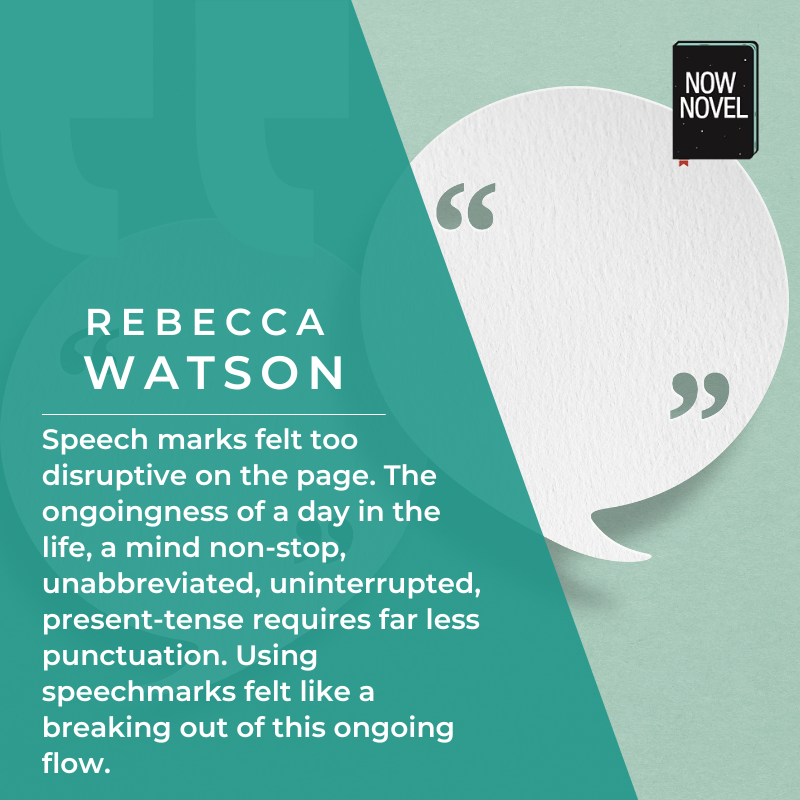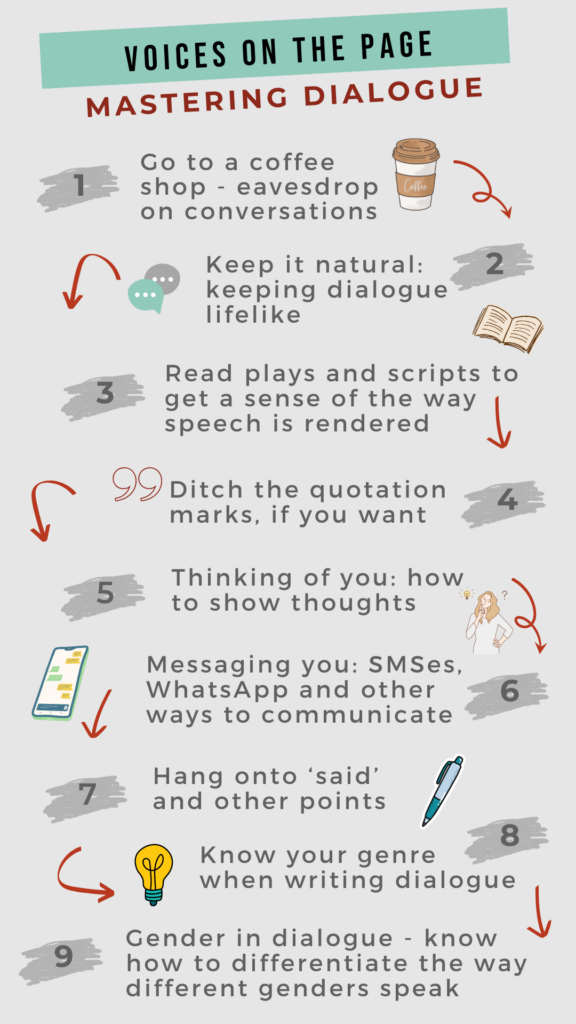Dialogue is a fictional tool: it is not the kind of conversation you would have in real life, and nor should it be. In real life we ask our partners if they have remembered to buy the milk, and if they say yes, that’s it. That’s hardly riveting conversation. There’s no ‘story’ in this simple exchange, unless our partner says no, and we fly into a rage, trigged again by how forgetful our partner is, or how this relationship is unravelling, and our partner doesn’t care anymore.
But the central job of dialogue in a novel is to move the plot forward, provide exposition and reveal who the characters are. As such a conversation like the one above about remembering to buy the milk doesn’t move the story forward at all. There’s no tension and conflict here. And including such a scene would be boring for a reader to encounter.
Dialogue is, of course, communication between two or more characters in a fictional work. Such communication can be spoken, but it can also include text messages, emails, or what a character is thinking. Some writers find dialogue easy – but struggle with pacing or plot. But many, many writers struggle with dialogue and how to keep it natural, without necessarily imitating conversations in life that are full of ‘umms’ and hesitancies, and unanswered questions, and backtracking, among other quirks.
Here is a complete guide to dialogue.
Let’s look at how to improve the writing of dialogue in fiction, as well as some other considerations.
Go to a coffee shop
Firstly, perfect the art of eavesdropping. Go to a coffee shop on your own, but instead of trying to tune out the background noise of other people talking, tune into a conversation. Notice how people interrupt each other, do not answer each other’s questions, write in incomplete sentences and so on. You wouldn’t want to reproduce an entire conversation from real life, it would be boring and would put your reader off.
Firstly, perfect the art of eavesdropping. Go to a coffee shop on your own, but instead of trying to tune out the background noise of other people talking, tune into a conversation.
Tweet This
But the point of this exercise is to pick up on the quirks that we all have when speaking, and to use those to differentiate between different characters. I knew a man who often punctuated his speech with, ‘I tell you …’; I also knew a woman who used the exclamation, ‘Good Lord!’. I could use these verbal ticks in creating a character, but I’d use them sparingly, of course. If I had too many ‘Good Lords!’ and ‘I tell you..’ it would end up being a caricatured use of the tick. But used sparingly, it would highlight differences between characters.
Keep it natural
However, although you can’t—and wouldn’t want to—replicate everyday speech verbatim, you still have to keep it natural. For this I recommend recording two friends in conversation, transcribe it, and the edit it. Remove the ‘umms’ and ‘ahhs’, the incomplete sentences, but keep the essence and thread of the conversation. Reproducing natural speech verbatim is going to put your reader to sleep. In John Hough’s The Fiction Writer’s Guide to Dialogue, he reproduces a large section of the Watergate tapes. This is Nixon’s chief of staff HR Haldeman:
Now, on the investigation, you know, the Democratic break-in thing, we’re back to the—in the, the problem area because the FBI is not under control . . . and they have, their investigation is now leading into some productive areas, because they’ve been able to trace the money, not through the money itself, but through the bank, you know, sources… And it goes in some directions we don’t want it to go.
Hough writes:
If you skipped any of this—or most of it—I don’t blame you. Riveting reading, it is not. It’s meandering. It’s repetitive. There are pointless-seeming interruptions. Some of it is hard to follow, some of it is nearly unintelligible. What’s going on here? Richard Nixon, whatever you think of him, was educated and far from stupid. He was articulate in public. H. R. Haldeman was an advertising executive and a graduate of UCLA.
So why is the dialogue between two powerful and intelligent men conniving in a felony so insipid in print? The answer is all around you, in the dialogue you hear every hour of every day, and in the words you speak yourself. It’s the way we talk: the unfinished sentence, the sudden shift of topic, the empty pause, the repetition, the interruptions. In real life we digress. We ramble. We elaborate needlessly. We use three or four sentences, three or four words, where one would do.
As the Watergate tapes demonstrate, dialogue in fiction is not derived from real life. If it were, you’d bore the reader, probably confuse him, and triple the length of your novel. The dialogue writer is not a stenographer, writing down what he hears; he’s an extrapolator, a rewrite man, bringing coherence to our oral discourse, condensing what we say and giving it shape and cohesion.
Here are more ways and tools to keep dialogue natural.
Tweet This
an be f Another excellent way of learning to write dialogue is to read plays and film scripts. It can be eye-opening to compare the dialogue used, and how it contributes to the telling of a story.
JOIN OUR COACHING PROGRAM
Stay accountable, in a structured program with writing sprints, coach Q&As, webinars and feedback in an intimate writing group.
LEARN MORE
Read plays and scripts
Another excellent way of learning to write dialogue is not only to read a wide variety of novels, of course, but to read plays and film scripts, especially if you have seen the productions. Here we have dialogue stripped of exposition and description, of course, but it can be eye-opening to compare the dialogue used, and how it contributes to the telling of a story, which all dialogue must do, whether it’s part of a novel or a play. Notice the way the playwright has rendered different character’s speech. Notice differences in class, if there are any, or differences in the way the speech between men and women is rendered. And notice how the dialogue is often pared back, every line is in service of the story.

Ditch the quotation marks, if you want
Dialogue is mostly commonly indicated by the use of quotation or speech marks around the spoken language. In the US, the double quotation mark is mostly used; while UK publications mostly use single quote marks. This is the conventional way of showing speech, of course, a reader’s eye would naturally ‘glide’ over the marks, while also registering them.
But consider that you can ditch the quotation marks. James Joyce did this in his novels, calling the quotation marks ‘perverted marks’. While some modern editions have (scandalously) inserted quotation marks, this is the way Joyce has it in Ulysses, using em dashes at the beginning of each line of dialogue:
—Tell me, Mulligan, Stephen said quietly.
—Yes, my love?
—How long is Haines going to stay in this tower?
Nadine Gordimer also took up this use, after initially using conventional punctuation in her short stories and novels. But she adds an extra em dash when the character has stopped speaking.
—Has something happened to one of the boys? What man?—
There are some writers that have eschewed using any sort of marks to indicate punctuation, Cormac McCarthy has done so, as has Sally Rooney. In their novels, the dialogue is ‘part’ of the narration. For example here are some lines of dialogue from Normal People:
What were you talking to Miss Neary about today? says Marianne.
Oh. Nothing. I don’t know. Exams.
Marianne twists the spoon around inside the jar.
Does she fancy you or something? Marianne says.
Connell watches her moving the spoon. His ears still feel very hot.
Why do you say that? he says.
McCarthy discusses this in an interview with Oprah Winfrey, saying, ‘There’s no reasons to blot the page up with weird little marks.’
Rebecca Watson has said: ‘Speech marks felt too disruptive on the page. The ongoingness of a day in the life, a mind non-stop, unabbreviated, uninterrupted, present-tense requires far less punctuation. Using speech marks felt like a breaking out of this ongoing flow.’
Whatever your choice, consider that using unusual ways of marking speech might be difficult for your readers. It might turn them off, or it might not bother them at all!
For a delightful potted history of these ‘weird little marks’ have a read of Penguin’s blog.
Thinking of you
Related to the issue of rendering speech with quotation marks – or not – is the decision of how to depict thoughts. It’s considered old-fashioned these days to put thoughts into quotation marks. Writers today do it in one of two ways: either by rendering thought in italics, or having thoughts stand as part of the text, as you would if you were dispensing with the quotation marks.
For example:
John walked outside. He thought, I wonder what Mae is up to.
John walked outside. He thought, I wonder what Mae is up to.
Personally, I prefer leaving thoughts as part of the natural text, not using italics. For me italics calls attention to the thought, highlighting in rather a ‘shouty’ way.
Messaging you
Another way that characters communicate in fiction is through instant messaging apps, such as WhatsApp, sometimes SMSes and through email or even letters. Before the advent of smartphones, when we were stuck with tappng out messages on numerical keyboards and using predictive text, messages were shorter, more abbreviations were used. Consider this when using such messages to advance your plot. If you’re wanting to set your story in the early 2000s, don’t include perfect grammatical text messages.
Moving back to the present, your character might be a professor of English and hates using ungrammatical language. Their messages will, more than likely, be correct, they might even go to the (some will say it’s pedantic) trouble of using italics in their WhatsApp messages when referring to a title of a movie or book. A teenager will text differently to an adult, there will be more abbreviations. Consider all this when using this form of communication in your fiction.
MAKE USE OF OUR EDITNG SERVICES
We offer a range of editing services –from copy-editing to developmental editing, showing how you can improve your story. We’ll help you polish your manuscript
GET A QUOTE
Hang onto ‘said’
Here are some more considerations to consider when writing dialogue. Hang onto ‘said’. While it’s tempting to use a range of words, ‘gasped’, ‘hollered’, ‘guffawed’, use them sparingly. The value of ‘said’ is that it’s almost an invisible, yet guiding mark. The reader’s eye tends to elide over the word, and so the flow of the dialogue isn’t interrupted. ‘Said’ might sound boring, but it’s anything but.
There are times though, when you’ll want to leave ‘said’ alone. Such as with adverbs: consider using them sparing. For example, instead of saying, ‘She said softly’, consider saying, ‘she whispered’. ‘Whispered’ conveys a much more precise way of conveying how something was said.
Another worry is that all your characters might sound the same. This is why it’s useful to notice what and how people are speaking around you, and to make notes of the way people say things. For example, an older person might use the word ‘super’ on its own: ‘That was a super play!’ Younger people will say something is ‘super crazy’, using the super as a modifier.
Gloria Kempton has some advice in Dialogue: techniques and exercises for creating effective dialogue:
What if my characters start talking and they all sound the same? … After all, you’re the one writing this story. It’s your voice. You only have one voice.
At least that’s what we think. Have you ever gotten mad at your kids? Made love? Worked in corporate America? Is your voice the same for all of these situations? I didn’t think so. You can play different roles and your voice is just a little adjusted for all of them. Not your personality— your voice. This is what you have to understand in order to create all of these different characters and make sure they don’t all sound the same.
Know your character. Ground yourself in all of their personas, protagonist and antagonist alike and all minor characters, no matter how unlikable. Write first-person character sketches, letting your characters tell you who they are. How do you get to know real people? By spending time with them. The more time you spend with them, the better you get to know them, and soon you can hardly remember when you didn’t know them.
Another interesting way of getting to know how your character speaks is to interview them. See how they talk. Imagine interviewing your 16-year-old male protagonist, asking him how what he’s going to do about something. Mine is kicking a soccer ball, not looking at me, and saying, ‘Dunno.’ My English professor character is saying, ‘Well, I’m not quite sure.’ Immediately, a picture of difference is painted in the language the two characters speak.
Avoid using dialogue as a means to convey information or backstory in a forced manner. When characters start explaining things solely for the reader’s benefit, it can feel unnatural. Instead, try to integrate information into the story more organically.
Remember that dialogue shouldn’t always be harmonious. Conflict and tension can make conversations more engaging. Characters should have differing opinions, goals, or motivations that lead to interesting interactions.

Know your genre
This is an interesting one, and one you might not have considered before. Different characters speak differently in a romance novel, compared to a sci-fi to a mystery or a literary novel.
Kempton explains in Dialogue: techniques and exercises for creating effective dialogue: ‘A fast-paced action adventure needs fast-paced dialogue in every scene to keep the story moving quickly forward. Likewise, a literary story needs the dialogue to match the pace of the other elements in the story— it needs to move more slowly.’
She demonstrates this with some fantastic examples. Here’s an excerpt where she talks about ‘magical’ dialogue.
The language of The Hobbit, Star Wars, The Lord of the Rings, Star Trek, and The Wonderful Wizard of Oz appeals to readers who are looking for the magical. ‘May the Force be with you’ would sound ridiculous in a mainstream or literary novel. Real people just don’t talk like that. Readers of mainstream and literary stories know what’s real and what isn’t. When writing mainstream and literary stories, we have to go with what is real. Science fiction and fantasy writers can write about what isn’t real, but it’s not as easy as it sounds.
Some of us have the ability to write magical dialogue, and some of us don’t. Magical dialogue sounds truly authentic coming from an author like J.R.R. Tolkien. But can you imagine Holden Caulfield telling his sister, ‘May the Force be with you’? If he had even hinted at it, J.D. Salinger would not be the famous author he is today.
In looking at romance writing, Kempton explains that it’s still magical in that ‘it but it’s ‘magical in that it transcends the way we talk to each other in normal society in this century’. Meanwhile cryptic dialogue: ‘Sometimes other novels will have bits of cryptic dialogue when the plot calls for some things to remain hidden or secret. These bits of dialogue plant subliminal messages in the reader’s mind that help to communicate the story’s theme and will ultimately make sense if the author is able to successfully pull the story off at the end.’
The takeaway is simple: match your dialogue to the genre of your novel. Read widely in that genre to get a good sense of the type of dialogue that is used. Some genres will use lots of jargon: a crime novel will have references to gun types, perhaps; a romantic novel is probably unlikely to have such references.

Gender in dialogue
This is something that you may – or may not – have thought about: that dialogue is often gendered, and that male and female characters may well speak differently. Writer’s Digest explore this in detail. Rachel Scheller includes a checklist for men writing as women characters and women as men. For example:
If You’re a Woman
Here’s how to make your hero’s dialogue more true to gender if you’re a female writer:Check for questions. Men tend to request specific information, rather than ask rhetorical questions. If your hero’s questions can’t be answered with a brief response, can you rephrase them? Instead of asking questions at all, can he make statements?
Check for approval-seeking behavior. Men tend to be direct rather than ask for validation or approval. Can you make your hero’s comments less dependent on what the other person’s reaction might be?
If You’re a Man
Here’s how to make your heroine’s dialogue more realistic if you’re a male writer:Check for advice. Women tend to sympathize and share experiences rather than give advice. Can you add empathy to your character’s reactions and have her talk about similar things that happened to her, rather than tell someone what he should do?
Check for bragging. Women tend to talk about their accomplishments and themselves in a self-deprecating fashion rather than a boastful one. Can you rephrase her comments in order to make her laugh at herself?
There are plenty more examples of this and it makes for useful, and interesting points to ponder.
For other ways to write realistic dialogue browse our articles on writing realistic dialogue and natural dialogue. Another guide to writing dialogue will take you through seven dialogue rules. We also have a useful guide to writing accents and dialects.


